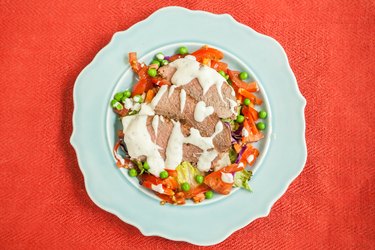
A saltwater brine improves a pork butt's moisture retention. Salt breaks down proteins, creating microscopic spaces in the meat. The fibers subsequently absorb water to fill the spaces, making the meat more moist. Meat naturally loses moisture when you cook it. But brined meat has moisture to spare, so it is juicier than unbrined meat. Many pork roasts are pre-seasoned when you buy them; brining pre-treated pork will yield meat that is too salty. Pork labeled "extra-tender" has generally been pre-treated. Check the packaging or ask the butcher to guarantee you are buying unseasoned pork.
Basic Saltwater Mixture
Video of the Day
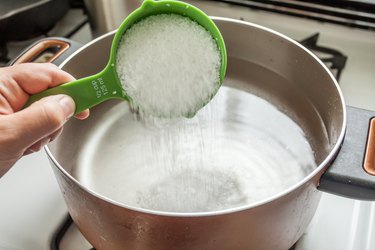
Create enough brine to completely submerge the pork butt -- use at least 1/2 gallon of water. Heat the water on the stove, setting the burner to medium heat. Salts vary in concentration; the volume you need depends on the type of salt you use. Add 1 cup of Diamond Crystal kosher salt, 3/4 cup of Morton's kosher salt or 1/2 cup of table salt per 1/2 gallon of water. Add sugar to the mixture for flavor and to promote browning if desired. Use 3/4 cup of molasses, 1/4 cup of granulated sugar or 1/4 cup of brown sugar per 1/2 gallon of water.
Video of the Day
Additional Ingredients
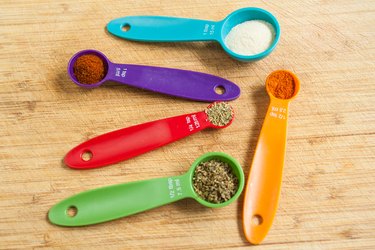
Flavor the brine with additional ingredients if desired. Proteins only absorb pure water, so the particles of flavoring in seasonings or other liquids won't penetrate the meat as deeply as the salt and water. Flavored ingredients in a brine will function like a marinade, imparting flavor about 1/8 inch deep into the pork butt. Substitute a flavored liquid such as apple juice for some of the water. Add a dry rub to a pork butt you plan to barbecue. Sage, thyme, rosemary, ground pepper, cayenne pepper, garlic powder and onion powder also complement pork. Avoid acidic ingredients such as apple cider vinegar, alcoholic beverages and citrus juice, which toughen raw meat.
Submerge the Pork
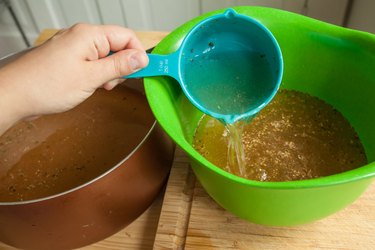
Remove the brine from the heat after you add all the ingredients -- except for the pork butt -- and the salt dissolves. Pour the brine into a large resealable plastic brining bag or a large bowl. Cool the brine in an ice-filled sink until it is 40 degrees Fahrenheit or below. Place the pork butt in the brine, submerging the meat entirely. Seal the bag or cover the bowl with plastic wrap.
Refrigerated Soaking Time
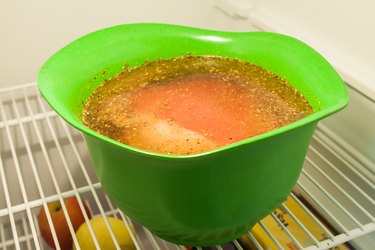
Refrigerate the pork throughout the entire brining process to prevent the growth of illness-causing organisms. Brine a pork butt that weighs 6 pounds or less for 12 to 18 hours. Brine larger shoulder roasts for an additional 2 to 3 hours per pound. For example, brine an 8-pound roast for 16 to 24 hours.
Injection Brining
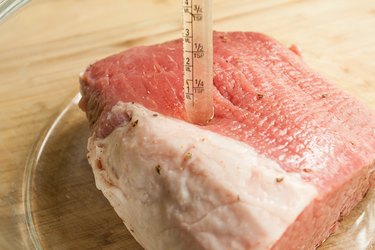
Inject brine into a pork butt with a marinade syringe or brining needle instead of submerging the meat, if desired. While brines can penetrate deep into meat, they can't reach the center of thicker cuts such as roasts. Add 3/4 cup of Diamond Crystal kosher salt, 1/2 cup of Morton's kosher salt or 1/4 cup plus 1 tablespoon of table salt per 1/2 gallon of water. Cool the brine, and remove flavored ingredients that do not dissolve before you fill the syringe. Working in equally spaced time intervals, insert the syringe across the entire surface of the pork butt. Inject about 1 tablespoon per injection to avoid over-salting the meat. Cover the pork and refrigerate for the recommended time.
After Brining
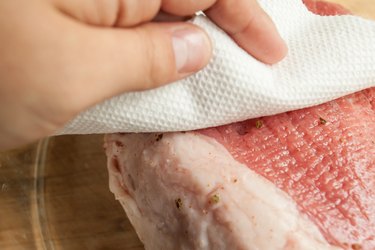
Rinse a submerged pork butt under cool running water to remove excess salt from the surface. Discard the brine. Pat the pork dry with paper towels. Apply additional seasonings to the surface of submersion-brined or injection-brined meat if desired. Cook the pork butt according to your recipe.